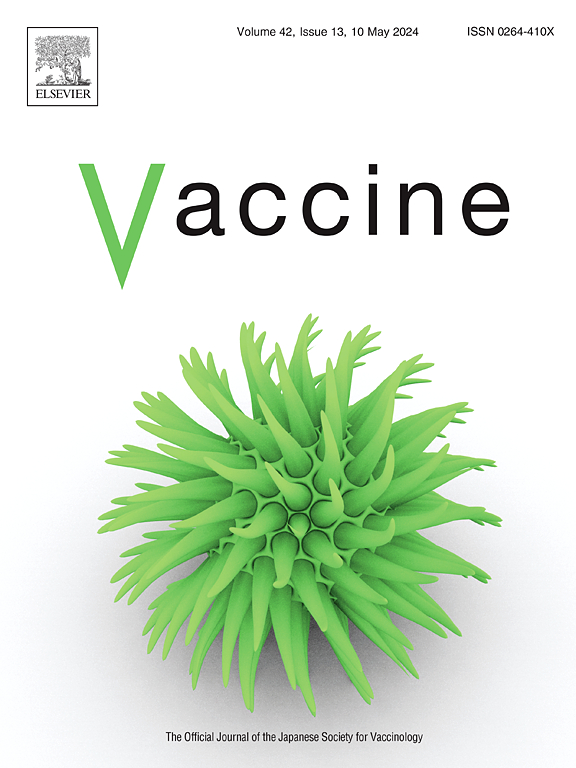Safety monitoring of health outcomes following influenza vaccination during the 2023–2024 season among U.S. Medicare beneficiaries aged 65 years and older
IF 4.5
3区 医学
Q2 IMMUNOLOGY
引用次数: 0
Abstract
Background
Influenza vaccination is widely recommended for individuals aged 6 months and older in the United States. While the safety of annual influenza vaccines is well established, FDA conducts routine monitoring and safety evaluations. This study assessed the safety of 2023–2024 influenza vaccines among elderly Medicare beneficiaries.
Methods
A self-controlled case series (SCCS) analysis compared incidence rate ratios (IRR) of anaphylaxis, encephalitis/encephalomyelitis/acute disseminated encephalomyelitis, Guillain-Barré syndrome (GBS), transverse myelitis, hemorrhagic stroke, non-hemorrhagic stroke, transient ischemic attack (TIA), and non-hemorrhagic stroke/TIA, following 2023–2024 seasonal influenza vaccinations in risk and control intervals among Medicare beneficiaries aged 65 years and older. We used conditional Poisson regression to estimate IRRs and 95 % confidence intervals (CIs) adjusted for event-dependent observation time for certain outcomes, seasonality, and uncertainty from outcome misclassification where feasible. For health outcomes with statistically significant associations, we stratified results by concomitant vaccination status.
Results
We observed 20,258,006 influenza vaccinees, and no statistically significant elevations of risk for anaphylaxis, encephalitis/encephalomyelitis (with ADEM), GBS, hemorrhagic stroke, or transverse myelitis. For the combined non-hemorrhagic stroke/TIA outcome (22–42-day risk window), we observed a small elevation in risk that was statistically significant in both the Fee-for-Service (IRR: 1.07; 95 % CI: 1.01, 1.14) and Medicare Advantage (IRR: 1.10; 95 % CI: 1.02, 1.17) populations that received a high-dose vaccine. This was also observed among Medicare Advantage beneficiaries that received any influenza vaccine (IRR: 1.11; 95 % CI: 1.01, 1.22). Additionally, we observed a small statistically significant risk for the individual TIA outcome (22–42-day risk window) among the Medicare Advantage population that received any influenza vaccine.
Conclusion
The benefits of seasonal influenza vaccines established by past studies likely outweigh the risks found in this study. The small, elevated risk of stroke outcomes must be carefully considered in light of the known benefits of influenza vaccination.
对美国 65 岁及以上医疗保险受益人在 2023-2024 年流感季节接种流感疫苗后的健康状况进行安全监测
背景:在美国,流感疫苗被广泛推荐给6个月及以上的个体。虽然每年流感疫苗的安全性已得到充分确认,但FDA仍进行常规监测和安全性评估。本研究评估了2023-2024年流感疫苗在老年医保受益人中的安全性。方法采用自我对照病例系列(SCCS)分析,比较65岁及以上Medicare受益人在2023-2024年季节性流感疫苗接种后发生的过敏反应、脑炎/脑脊髓炎/急性播散性脑脊髓炎、格林-巴勒综合征(GBS)、横贯脊髓炎、出血性卒中、非出血性卒中、短暂性脑缺血发作(TIA)和非出血性卒中/TIA的发病率比(IRR)。在可行的情况下,我们使用条件泊松回归来估计irr和95%置信区间(ci),这些置信区间是根据事件相关的观察时间、季节性和结果错误分类的不确定性进行调整的。对于统计上有显著关联的健康结果,我们根据同时接种疫苗的情况对结果进行分层。结果:我们观察到20,258,006名流感疫苗接种者,过敏反应、脑炎/脑脊髓炎(伴ADEM)、GBS、出血性中风或横贯脊髓炎的风险没有统计学显著升高。对于非出血性卒中/TIA合并结局(22 - 42天风险窗口),我们观察到在服务收费组(IRR: 1.07;95% CI: 1.01, 1.14)和Medicare Advantage (IRR: 1.10;95%可信区间:1.02,1.17)接种高剂量疫苗的人群。在接受任何流感疫苗的医疗保险优惠受益人中也观察到这一点(IRR: 1.11;95% ci: 1.01, 1.22)。此外,我们观察到,在接受任何流感疫苗的医疗保险优惠人群中,个体TIA结局(22 - 42天风险窗口)存在统计学上显着的小风险。结论以往研究确定的季节性流感疫苗的益处可能大于本研究发现的风险。鉴于流感疫苗接种的已知益处,必须仔细考虑卒中结果的小而高的风险。
本文章由计算机程序翻译,如有差异,请以英文原文为准。
求助全文
约1分钟内获得全文
求助全文
来源期刊

Vaccine
医学-免疫学
CiteScore
8.70
自引率
5.50%
发文量
992
审稿时长
131 days
期刊介绍:
Vaccine is unique in publishing the highest quality science across all disciplines relevant to the field of vaccinology - all original article submissions across basic and clinical research, vaccine manufacturing, history, public policy, behavioral science and ethics, social sciences, safety, and many other related areas are welcomed. The submission categories as given in the Guide for Authors indicate where we receive the most papers. Papers outside these major areas are also welcome and authors are encouraged to contact us with specific questions.
 求助内容:
求助内容: 应助结果提醒方式:
应助结果提醒方式:


